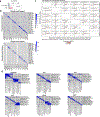Single-nucleus multiregion transcriptomic analysis of brain vasculature in Alzheimer's disease
- PMID: 37264161
- PMCID: PMC10464935
- DOI: 10.1038/s41593-023-01334-3
Single-nucleus multiregion transcriptomic analysis of brain vasculature in Alzheimer's disease
Erratum in
-
Author Correction: Single-nucleus multiregion transcriptomic analysis of brain vasculature in Alzheimer's disease.Nat Neurosci. 2023 Dec;26(12):2251. doi: 10.1038/s41593-023-01507-0. Nat Neurosci. 2023. PMID: 37907809 No abstract available.
Abstract
Cerebrovascular dysregulation is a hallmark of Alzheimer's disease (AD), but the changes that occur in specific cell types have not been fully characterized. Here, we profile single-nucleus transcriptomes in the human cerebrovasculature in six brain regions from 220 individuals with AD and 208 age-matched controls. We annotate 22,514 cerebrovascular cells, including 11 subtypes of endothelial, pericyte, smooth muscle, perivascular fibroblast and ependymal cells. We identify 2,676 differentially expressed genes in AD, including downregulation of PDGFRB in pericytes, and of ABCB1 and ATP10A in endothelial cells, and validate the downregulation of SLC6A1 and upregulation of APOD, INSR and COL4A1 in postmortem AD brain tissues. We detect vasculature, glial and neuronal coexpressed gene modules, suggesting coordinated neurovascular unit dysregulation in AD. Integration with AD genetics reveals 125 AD differentially expressed genes directly linked to AD-associated genetic variants. Lastly, we show that APOE4 genotype-associated differences are significantly enriched among AD-associated genes in capillary and venule endothelial cells, as well as subsets of pericytes and fibroblasts.
© 2023. The Author(s), under exclusive licence to Springer Nature America, Inc.
Conflict of interest statement
Competing Interests
The authors declare no competing interests.
Figures

















References
-
- Vanlandewijck M et al. A molecular atlas of cell types and zonation in the brain vasculature. Nature 554, 475–480 (2018). - PubMed
Publication types
MeSH terms
Grants and funding
- R01 AG074003/AG/NIA NIH HHS/United States
- RF1 AG062377/AG/NIA NIH HHS/United States
- P30 AG010161/AG/NIA NIH HHS/United States
- R01 NS127187/NS/NINDS NIH HHS/United States
- RF1 AG057473/AG/NIA NIH HHS/United States
- R01 AG062335/AG/NIA NIH HHS/United States
- U01 MH119509/MH/NIMH NIH HHS/United States
- R01 AG015819/AG/NIA NIH HHS/United States
- P30 AG072975/AG/NIA NIH HHS/United States
- U01 DA053631/DA/NIDA NIH HHS/United States
- RF1 AG054012/AG/NIA NIH HHS/United States
- U01 AG046152/AG/NIA NIH HHS/United States
- R01 AG058002/AG/NIA NIH HHS/United States
- R01 HG008155/HG/NHGRI NIH HHS/United States
- U01 AG061356/AG/NIA NIH HHS/United States
- UG3 NS115064/NS/NINDS NIH HHS/United States
- R01 AG017917/AG/NIA NIH HHS/United States
- UH3 NS115064/NS/NINDS NIH HHS/United States
- U01 NS110453/NS/NINDS NIH HHS/United States
- R56 AG067151/AG/NIA NIH HHS/United States
- R01 AG015473/AG/NIA NIH HHS/United States
- R01 AG067151/AG/NIA NIH HHS/United States
- R01 MH109978/MH/NIMH NIH HHS/United States
LinkOut - more resources
Full Text Sources
Medical
Miscellaneous

